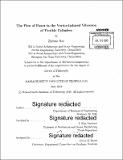| dc.contributor.advisor | J. Kim Vandiver. | en_US |
| dc.contributor.author | Rao, Zhibiao | en_US |
| dc.contributor.other | Massachusetts Institute of Technology. Department of Mechanical Engineering. | en_US |
| dc.date.accessioned | 2015-12-03T20:56:04Z | |
| dc.date.available | 2015-12-03T20:56:04Z | |
| dc.date.copyright | 2015 | en_US |
| dc.date.issued | 2015 | en_US |
| dc.identifier.uri | http://hdl.handle.net/1721.1/100141 | |
| dc.description | Thesis: Ph. D., Massachusetts Institute of Technology, Department of Mechanical Engineering, 2015. | en_US |
| dc.description | Cataloged from PDF version of thesis. | en_US |
| dc.description | Includes bibliographical references (pages 255-259). | en_US |
| dc.description.abstract | In this thesis techniques are developed which permit the identification of power-in and power-out regions of long cylinders exposed to flow-induced vibration. The data used to illustrate the techniques come from a set of vortex-induced vibration model tests conducted by Shell Oil Co in 2011 at the Marintek facility in Trondheim, Norway. The identification of power-in regions allows one to address the practical problem of determining the primary source of vibration energy when the long cylinder has components of various shapes, such as when buoyancy modules are used in staggered configurations. The identification of power-out regions has a direct practical connection to the estimation of damping magnitude and location on cylinders with varying cross-sections in non-uniform flows. The vibration intensity technique is used in this thesis to locate the power-in and power-out regions of a long flexible cylinder in a steady flow. This method also allows the exploration of the occurrence of secondary power-in regions after suppressing the primary power-in zones. Results may provide useful guidance for the installation and repair of suppression devices such as helical strakes. Three methods are presented to address a practical problem: "When buoyancy modules are applied in a staggered pattern on an otherwise bare cylinder, which distribution patterns result in VIV response dominated by buoyant or bare regions?" Based on the data analysis of five staggered buoyancy pipes, the three methods yielded the same results in identifying the winner. A dimensionless parameter, the "predictor", is proposed. The predictor relies only on the diameters and lengths of bare and buoyant segment. The predictor is verified with an independent set of VIV tests. An equivalent damping parameter is proposed for the purpose of classifying all flexible cylinder VIV response cases onto a single plot of response versus the equivalent damping parameter. After taking Reynolds number into account, results show that the amplitude for pipes with and without helical strakes at different Reynolds numbers can be collapsed onto a single curve as a function of the newly defined equivalent damping parameter. | en_US |
| dc.description.statementofresponsibility | by Zhibiao Rao. | en_US |
| dc.format.extent | 259 pages | en_US |
| dc.language.iso | eng | en_US |
| dc.publisher | Massachusetts Institute of Technology | en_US |
| dc.rights | M.I.T. theses are protected by copyright. They may be viewed from this source for any purpose, but reproduction or distribution in any format is prohibited without written permission. See provided URL for inquiries about permission. | en_US |
| dc.rights.uri | http://dspace.mit.edu/handle/1721.1/7582 | en_US |
| dc.subject | Mechanical Engineering. | en_US |
| dc.title | The flow of power in the vortex-induced vibration of flexible cylinders | en_US |
| dc.type | Thesis | en_US |
| dc.description.degree | Ph. D. | en_US |
| dc.contributor.department | Massachusetts Institute of Technology. Department of Mechanical Engineering | |
| dc.identifier.oclc | 930146045 | en_US |
